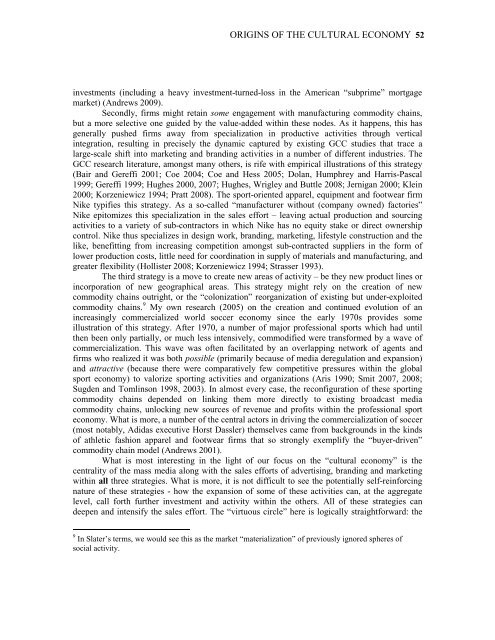Entire Volume 17 issue 1 - Journal of World-Systems Research ...
Entire Volume 17 issue 1 - Journal of World-Systems Research ...
Entire Volume 17 issue 1 - Journal of World-Systems Research ...
You also want an ePaper? Increase the reach of your titles
YUMPU automatically turns print PDFs into web optimized ePapers that Google loves.
ORIGINS OF THE CULTURAL ECONOMY 52<br />
investments (including a heavy investment-turned-loss in the American “subprime” mortgage<br />
market) (Andrews 2009).<br />
Secondly, firms might retain some engagement with manufacturing commodity chains,<br />
but a more selective one guided by the value-added within these nodes. As it happens, this has<br />
generally pushed firms away from specialization in productive activities through vertical<br />
integration, resulting in precisely the dynamic captured by existing GCC studies that trace a<br />
large-scale shift into marketing and branding activities in a number <strong>of</strong> different industries. The<br />
GCC research literature, amongst many others, is rife with empirical illustrations <strong>of</strong> this strategy<br />
(Bair and Gereffi 2001; Coe 2004; Coe and Hess 2005; Dolan, Humphrey and Harris-Pascal<br />
1999; Gereffi 1999; Hughes 2000, 2007; Hughes, Wrigley and Buttle 2008; Jernigan 2000; Klein<br />
2000; Korzeniewicz 1994; Pratt 2008). The sport-oriented apparel, equipment and footwear firm<br />
Nike typifies this strategy. As a so-called “manufacturer without (company owned) factories”<br />
Nike epitomizes this specialization in the sales effort – leaving actual production and sourcing<br />
activities to a variety <strong>of</strong> sub-contractors in which Nike has no equity stake or direct ownership<br />
control. Nike thus specializes in design work, branding, marketing, lifestyle construction and the<br />
like, benefitting from increasing competition amongst sub-contracted suppliers in the form <strong>of</strong><br />
lower production costs, little need for coordination in supply <strong>of</strong> materials and manufacturing, and<br />
greater flexibility (Hollister 2008; Korzeniewicz 1994; Strasser 1993).<br />
The third strategy is a move to create new areas <strong>of</strong> activity – be they new product lines or<br />
incorporation <strong>of</strong> new geographical areas. This strategy might rely on the creation <strong>of</strong> new<br />
commodity chains outright, or the “colonization” reorganization <strong>of</strong> existing but under-exploited<br />
commodity chains. 9<br />
My own research (2005) on the creation and continued evolution <strong>of</strong> an<br />
increasingly commercialized world soccer economy since the early 1970s provides some<br />
illustration <strong>of</strong> this strategy. After 1970, a number <strong>of</strong> major pr<strong>of</strong>essional sports which had until<br />
then been only partially, or much less intensively, commodified were transformed by a wave <strong>of</strong><br />
commercialization. This wave was <strong>of</strong>ten facilitated by an overlapping network <strong>of</strong> agents and<br />
firms who realized it was both possible (primarily because <strong>of</strong> media deregulation and expansion)<br />
and attractive (because there were comparatively few competitive pressures within the global<br />
sport economy) to valorize sporting activities and organizations (Aris 1990; Smit 2007, 2008;<br />
Sugden and Tomlinson 1998, 2003). In almost every case, the reconfiguration <strong>of</strong> these sporting<br />
commodity chains depended on linking them more directly to existing broadcast media<br />
commodity chains, unlocking new sources <strong>of</strong> revenue and pr<strong>of</strong>its within the pr<strong>of</strong>essional sport<br />
economy. What is more, a number <strong>of</strong> the central actors in driving the commercialization <strong>of</strong> soccer<br />
(most notably, Adidas executive Horst Dassler) themselves came from backgrounds in the kinds<br />
<strong>of</strong> athletic fashion apparel and footwear firms that so strongly exemplify the “buyer-driven”<br />
commodity chain model (Andrews 2001).<br />
What is most interesting in the light <strong>of</strong> our focus on the “cultural economy” is the<br />
centrality <strong>of</strong> the mass media along with the sales efforts <strong>of</strong> advertising, branding and marketing<br />
within all three strategies. What is more, it is not difficult to see the potentially self-reinforcing<br />
nature <strong>of</strong> these strategies - how the expansion <strong>of</strong> some <strong>of</strong> these activities can, at the aggregate<br />
level, call forth further investment and activity within the others. All <strong>of</strong> these strategies can<br />
deepen and intensify the sales effort. The “virtuous circle” here is logically straightforward: the<br />
9<br />
In Slater’s terms, we would see this as the market “materialization” <strong>of</strong> previously ignored spheres <strong>of</strong><br />
social activity.





